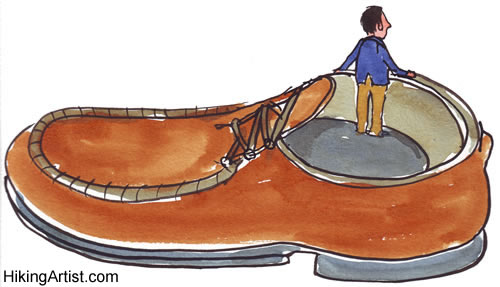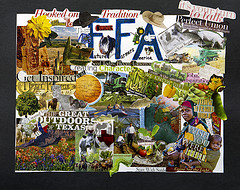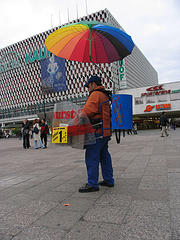|
|
|
Friday, September 7th, 2018

A Friday series exploring Startups and the people who make them go. Read all If the Shoe Fits posts here.
I love sandwiches.
My wife says I grew up in a “sandwich culture.” She grew up in the American South where people sat down to eat full meals a lot. We did that too in New York City, where I grew up, but sandwiches were a key part of life.
I’d stop by the deli on my way to my job after the school day was done and pick up the sandwich that would be my “dinner” that night. I rotated through roast beef and corned beef and pastrami. Cheese. Rye bread. I’d use some of my earnings to buy sandwich fixings for the weekend when I didn’t work. The best sandwiches were the ones you ate leaning over the sink.
Sometime in the last twenty years, sandwiches changed. The bread got flimsy and there was a lot less meat. People wanted to eat healthy so they cut back on the bread and the meat, but kept the cheese. Then came “low calorie” cheese.
Ugh. Low calorie cheese tastes like drywall. I kept my rye bread and I wanted a slab of cheddar or swiss on my roast beef, but I was the exception.
The sandwich in the age of the obesity epidemic
The challenge was pretty straightforward. As cheese became a more and more important part of the sandwich, people wanted it to taste good. Cheese makers responded by making low calorie cheese in various formulations. It tasted like drywall. They tried other formulas. It still tasted like drywall. Then the people at Sargento rethought the challenge.
Sargento: a history of innovation
Sargento is a big player in the packaged cheese business. They’re also a family owned company that’s been around since the 1950s with a history of innovation. In 1969, they introduced the pegbar system that’s now standard in supermarkets. They were the first to use re-sealable packages for cheese and the first to package shredded cheese.
Changing the challenge
The company figured that whatever they came up with would have to meet two criteria. It would have to use real cheese, not low-calorie, horrid tasting “cheese.” In other words, it would have to taste the way customers wanted cheese to taste. And, each slice would have to have no more than 45 calories.
Somebody at Sargento must have thought: “We can’t make low calorie cheese that tastes good. And we can’t offer smaller slices. What if we could reduce the calories in a slice of cheese by slicing real cheese thinner?”
The new challenge
That’s a great idea, but existing equipment couldn’t do it. Sargento could slice the cheese thinner, but then the slices would stick together. Whatever they came up with would have to work with existing packaging. Meeting that challenge took a $20 million investment in new technology. Sargento made it work.
The big payoff
Ultra-Thin Slices were released in 2012 and did $60 million in sales the first year. The second year sales more than doubled to $157 million. Even better, Ultra-Thin Slices attracted a lot of people who weren’t eating packaged cheese before. In other words, much of the sales growth was from new customers. That’s a breakthrough innovation by any standard.
What you can learn from Sargento’s Ultra-Thin Slices: rethinking the challenge
The breakthrough innovation didn’t happen until someone reconceived the challenge. Before, everyone, including Sargento, had conceived the challenge as coming up with a lower calorie cheese. When Sargento changed that to “slice cheese thinner so it’s only 45 calories” solutions became obvious.
What you can learn from Sargento’s Ultra-Thin Slices: the courage of conviction
It looks obvious now, but it took real courage to commit $20 million to develop new technology to support the reconception of the challenge. It may not have been a “bet the company” moment, but it was close.
Bottom Lines
Great innovation will not happen until you think of the challenge differently.
Making a great innovation a reality will not happen without courage.
Originally published at Three Star Leadership in 2016.
Image credit: HikingArtist
Posted in Entrepreneurs, If the Shoe Fits, Innovation | No Comments »
Monday, March 28th, 2016
It’s amazing to me, but looking back over a decade of writing I find posts that still impress, with information that is as useful now as when it was written. Golden Oldies is a collection of what I consider some of the best posts during that time.
Do you spend any time reading archives from sources you like? I don’t mean stuff that’s a few months old or even a couple of years. I mean thought pieces dating back 5, 10, 15 years ago or even more, especially those focused on what bosses need to do to motivate, retain and get the best from their teams. The problem is not in the content, nor how pertinent it is. The problem is that it’s still applicable, which means bosses haven’t changed much, if at all over all that time — but the workforce has. Here’s an example of what I mean. Read other Golden Oldies here.
My post yesterday brought an interesting question from Dan L. in Boston. He said, “Why in the world would any manager do anything that would reduce the options available to identify a solution needed in his/her group, especially a CEO?”
So, I paraphrased five reasons that I’ve actually heard, in one form or another, from top managers who talked about being out of the box, but really wanted to stay in it.
- Think outside—as long as it doesn’t make me uncomfortable.
- Don’t challenge the status quo in a manner that scares me.
- Be creative within parameters I can understand.
- If you want to breach the box, do it my way.
- We’ve never done it that way.
At first, Dan was incredulous, then he really thought about what’s behind each of the five reasons, and he understood what anybody who really listens to the thoughts behind people’s words comes to know.
Out of the box is about change, and change is scary—for everybody.
But it’s not about being scared, it’s about how you choose to handle it.
That’s right, choose.
Your responses, your choice.
Think about it this weekend.
Then, when you get to the office Monday and one of your people has a great idea that scares the dickens out of you, consciously choose how you respond—knowing that no matter how you choose the ripples of that choice will spread and impact not only your future, but also the future of your people and your company.
Posted in Golden Oldies, Motivation, Personal Growth | No Comments »
Thursday, February 27th, 2014

I’ve worked with hundreds of bosses and entrepreneurs over the years and there are two concepts I do my best to indoctrinate them with.
The first is a basic principle without which you can’t lead.
- Leadership outside-the-box starts inside your head.
The second is a corollary and acts as a guide anytime change is necessary.
- To change what they do, change how you think.
The point is that every boss in every organization at every level will lead/manage based on the way they think, what they think, how they think, and what they believe.
In other words, they will be guided by their MAP.
So if a boss wants her people to think/act/do things differently, then the way to accomplish that is for the boss to change first.
Flickr image credit: svilen001
Posted in Change, Entrepreneurs, Personal Growth | No Comments »
Friday, July 19th, 2013
 A Friday series exploring Startups and the people who make them go. Read all If the Shoe Fits posts here. A Friday series exploring Startups and the people who make them go. Read all If the Shoe Fits posts here.
The Top Five Things To Remember
If You’re A CEO
- Foremost, you are guardian of the big picture. You must clearly identify the goals of the company, then work with your people to turn them into specifics. Get their buy-in by making sure they understand how their personal goals, the company’s goals, and others’ interact. The biggest rewards at all levels should go to those who understand the company’s goals, and ethically do whatever is necessary to achieve them — especially when it takes precedence over their personal goals.
- You set the tone of the organization. If you’re political, secretive, nitpicking, or querulous, that is how your organization will be. No matter what — your people will do as you do, not as you say.
- People produce best if they know, and help determine, the range of their control — this is the RampUp Management Box. Their decisions inside the box are final; decisions outside it require approval. Through discussion of their performance, the box will grow or shrink. Your company’s strength will increase in direct proportion to your people’s growth, so make their boxes as big as possible.
- Never criticize an employee in the presence of others. Praise in public, criticize in private.
- People are your company’s most sustainable competitive edge. Enhance your people’s ability to do their jobs by clearly defining and communicating what they are.
Remember…
To change what they do…change how you think!™
Posted in If the Shoe Fits, Leadership | No Comments »
Tuesday, May 28th, 2013
 If your focus is to foster innovation you are unlikely to do it by hiring in your comfort zone. If your focus is to foster innovation you are unlikely to do it by hiring in your comfort zone.
Tech managers around the country are whining about the lack of available talent, because they ignore those caught in the 2008 crash and those who don’t fit the typical profile.
Autistic people are so far outside the box that the idea won’t even cross most managers’ minds, but it’s crossing the smartest—including SAP.
“By concentrating on the abilities that every talent brings to the table, we can redefine the way we manage diverse talents. With Specialisterne, we share a common belief that innovation comes from the ‘edges.’ Only by employing people who think differently and spark innovation will SAP be prepared to handle the challenges of the 21st century.” –Luisa Delgado, SAP human resources chief
When hiring you have a choice.
You can chase the same people as everyone else or you can turn your back on the tried and comfortable; there is an enormous amount of talent just lying around for the taking.
At least there is for the good managers who understand that their real job is to build, develop and support their people.
Flickr image credit: wallygrom
Posted in Hiring | No Comments »
Tuesday, December 18th, 2012
 Over the years some people take my expanding box idea and try and tell me that the boxes are actually replaced, not expanded as I described yesterday. Over the years some people take my expanding box idea and try and tell me that the boxes are actually replaced, not expanded as I described yesterday.
I (respectfully) tell them they are wrong.
It isn’t about replacement or creating boxes within boxes, it’s about expansion.
Everything that existed in the old box continues to exist, but new dimensions are added, because the box is larger.
And it especially isn’t about ‘using up’ what’s in your box before you can expand it; it’s about choosing to explore beyond what’s known and/or comfortable—or not.
We all push our boundaries organically as we age; it happens through experience and just plain living—and we’re not even conscious of doing it.
Some folks enjoy consciously pushing back boundaries in evolutionary ways, exploring new areas a bit at a time.
Others take a revolutionary approach and willingly leap into the unknown, not knowing where they will land or if they’ll survive. Very scary—but the unknown has always been scary.
Most of us combine all three types, organic, evolutionary and revolutionary, with ascendancy changing depending on what’s happening in our world—as well as the larger world.
What needs to be understood is that the person who leaps into the unknown is not intrinsically more valuable than the person whose box enlarges organically through their own life experiences or the ones whose boxes increase incrementally through conscious, measured efforts.
All three types, along with their varied, changing combinations, are necessary for life and for Life to continue on our planet.
Look at any list of great innovators from the past and then think of all the people who enhanced/changed/added to the original ideas; then add on all the lives involved, one way or another, with these ideas.
All the contributions have value within their own world—what is different is the size of each innovator’s world and since society tends to equate size to value—the bigger the greater the worth.
Not all of us want to/can change the world, but each of us can take care of/improve our little bit of it.
As for me, I’d hate to live in a world where all the little bits were a mess because everybody was out changing the whole.
Flickr image credit: Leonora Enking
Posted in Ducks In A Row, Personal Growth | No Comments »
Monday, December 17th, 2012
 We’re fast coming up on a new year. We’re fast coming up on a new year.
New ways of thinking can open up new opportunities.
So try this new way of thinking, rather than a bunch of New Year’s resolutions that may not last out the month.
Everybody has a box.
That’s right and no matter how hard you try you’ll never really think outside it.
Heresy? No.
The idea that boxes are bad is a function of how you interpret them.
It’s not the box that matters, but its size and how you address that.
Steve Jobs’ and Steven Spielberg’s boxes are immense, far larger than most, yet they both continue to enlarge them.
And therein lays one of the secrets of creativity, whether in an individual or organization.
It’s not about “thinking outside the box,” it’s about understanding your box and how to enlarge it.
Because that’s how it works.
As soon as you get outside your own box, a new one forms.
Once you totally use up its content and find its sides you go outside that box; a new one forms and the process begins again.
If you work at it, this process continues throughout your life—although some never start and some get comfortable in a certain box and retain it.
But the most wonderful thing about boxes is that it’s always your choice—within your control to make it happen.
There will always be a box, but with effort you can enlarge it enough to encompass galaxies—and even entire universes.
It’s all yours for the choosing.
Have you hugged (and enlarged) your box lately?
Flickr image credit: NASA
Posted in Personal Growth | No Comments »
Monday, November 28th, 2011
 What extracurricular activities do you look for in your entry level candidates? What extracurricular activities do you look for in your entry level candidates?
Too many mangers chess team means a thinker/problem solver, debate team assumes good verbal and written skills, captain of anything indicates a leader.
How impressed would you be if you saw FAA, i.e., Future Farmers of America on the resume?
Many managers would write that off as irrelevant at best and valueless at the least, unless it was an agriculture-related position.
Not so fast.
Consider Gamaliel Rizzo, an apartment dweller from Brooklyn who is studying to become a doctor. He says he spent more time honing skills like public speaking and developing business budgets than learning about farming.
“What amazes me is the degree to which they have made themselves relevant when by all expectations they should have simply ceased to exist.” –Pamela Riney-Kehrberg, historian at Iowa State University.
And it’s not just in the heartland that the FAA is thriving.
About 70 percent of its members live in rural areas, and 19 percent live in small towns. The fastest growing segment, however, is in urban and suburban areas, now making up 10 percent of the membership.
So what’s the take away on this?
If you want the unusual, look for the unusual.
If you want to hire people who think outside the norm then you should look for those who did things outside the norm.
If you need talent that will challenge conventional thinking and not cave to the nay-sayers look for the ones who went against the tide and persevered in spite of the cardinal sin of “not fitting in.”
It’s not that conventional activities, such as chess, debate and sports, aren’t good, but looking further, even if it’s not on the resume, will help you uncover the hidden gems that others miss.
Flickr image credit: Bush Library
Posted in Hiring | No Comments »
Thursday, March 3rd, 2011
 In my work with entrepreneurs the conversation frequently turns to creativity, the importance of “thinking outside the box” and how to encourage it. In my work with entrepreneurs the conversation frequently turns to creativity, the importance of “thinking outside the box” and how to encourage it.
With all the focus on entrepreneurs I thought it was a good time to revisit something I wrote a few years ago.
This is my own theory about boxes.
Everybody has a box.
That’s right and no matter how hard you try you’ll never really think outside it.
The idea that boxes are bad is a function of how you interpret them.
It’s not the box that matters, but its size and how you address that.
Steve Jobs’ and Steven Spielberg’s boxes are immense, far larger than most, yet they both continue to enlarge them.
And therein lays one of the secrets of a creative organization.
It’s not about encouraging your people to “think outside the box,” but about helping each to understand their own box and how to enlarge it.
Use up your box’s content, find its sides, move beyond them, a new box forms and the process begins again.
Because that’s how it works—each time you move outside your box, a new one forms.
If you work at it, this process continues throughout your life—although some never start it and some get comfortable in a certain box and retain it.
The most wonderful thing about boxes is that whether you remain, enlarge or retain, it’s always your choice and within your control to make it happen.
There will always be a box, but with effort you can enlarge it enough to encompass galaxies—and even entire universes.
It’s all yours for the choosing.
What do you do to enlarge your box?
Image credit: NASA
Posted in Entrepreneurs | 1 Comment »
Friday, September 25th, 2009
Last Friday I shared the story of politically incorrect innovation that feeds you and today I have another innovative food story.
 It involves innovation driven first by the loss of a job and juiced by government bureaucracy and the nonavailability of ever getting a food cart permit. And before you start wondering which municipality in what State is causing someone grief, this story takes place in Germany—a country that makes US bureaucracy look like a bunch of amateurs. It involves innovation driven first by the loss of a job and juiced by government bureaucracy and the nonavailability of ever getting a food cart permit. And before you start wondering which municipality in what State is causing someone grief, this story takes place in Germany—a country that makes US bureaucracy look like a bunch of amateurs.
The story involves Bertram Rohloff, who lost his job in 1997; he wanted to open a sandwich stand, but the required permits were impossible to obtain.
Rohloff started thinking; he knew that Germans love sausages and that permits made selling sidewalk food impossible, so he set out to invent a way to cook brats where neither the grill nor the sausages touched the ground.
Enter the Grillwalker.
“He designed it with an automatic cut-off mechanism for the gas, to ensure that it was safe in the event of an accident.
“Mr. Rohloff was the first person to don his invention and sell bratwurst on the street. He now has 15 employees selling sausages around the city in teams of two; they take turns wearing the grill and reloading the sausages, rolls and condiments. … He has subcontractors renting them in cities around the country, from Hanover to Karlsruhe.”
But Rohloff has bigger plans than a crew selling brats.
“And Mr. Rohloff has sold the equipment, at $7,100 a piece, to customers in Bulgaria, Colombia, South Korea and elsewhere, including one to a man in Nebraska. Just this week he sold one to a client in South Africa, which next year will host the World Cup soccer tournament.”
Rohloff’s situation necessitated his finding another way to earn a living; once he found it he needed to circumvent the bureaucracy that prevented his doing it; the result is far beyond the simple sandwich stand he originally envisioned. And those who work for him are earning more than their old jobs provided.
One guy, one idea, many people benefiting.
Anything is possible!
Watch the video and let it inspire you.
Image credit: Paul Keller on flickr
Posted in Business info, Innovation, Leadership | No Comments »
|
 Subscribe to
Subscribe to
MAPping Company Success
About Miki 
Clarify your exec summary, website, etc.
Have a quick question or just want to chat? Feel free to write or call me at 360.335.8054
The 12 Ingredients of a Fillable Req
CheatSheet for InterviewERS
CheatSheet for InterviewEEs™
Give your mind a rest. Here are 4 quick ways to get rid of kinks, break a logjam or juice your creativity!
Creative mousing
Bubblewrap!
Animal innovation
Brain teaser
The latest disaster is here at home; donate to the East Coast recovery efforts now!
Text REDCROSS to 90999 to make a $10 donation or call 00.733.2767. $10 really really does make a difference and you'll never miss it.
And always donate what you can whenever you can
The following accept cash and in-kind donations: Doctors Without Borders, UNICEF, Red Cross, World Food Program, Save the Children
*/
?>About Miki
About KG
Clarify your exec summary, website, marketing collateral, etc.
Have a question or just want to chat @ no cost? Feel free to write
Download useful assistance now.
Entrepreneurs face difficulties that are hard for most people to imagine, let alone understand. You can find anonymous help and connections that do understand at 7 cups of tea.
Crises never end.
$10 really does make a difference and you’ll never miss it,
while $10 a month has exponential power.
Always donate what you can whenever you can.
The following accept cash and in-kind donations:
|






 A Friday series exploring Startups and the people who make them go. Read all If the Shoe Fits posts
A Friday series exploring Startups and the people who make them go. Read all If the Shoe Fits posts  If your focus is to foster innovation you are unlikely to do it by
If your focus is to foster innovation you are unlikely to do it by  Over the years some people take my expanding box idea and try and tell me that the boxes are actually replaced, not expanded as I described yesterday.
Over the years some people take my expanding box idea and try and tell me that the boxes are actually replaced, not expanded as I described yesterday. We’re fast coming up on a new year.
We’re fast coming up on a new year. What extracurricular activities do you look for in your entry level candidates?
What extracurricular activities do you look for in your entry level candidates? In my work with entrepreneurs the conversation frequently turns to creativity, the importance of “thinking outside the box” and how to encourage it.
In my work with entrepreneurs the conversation frequently turns to creativity, the importance of “thinking outside the box” and how to encourage it. It involves innovation driven first by the loss of a job and juiced by government bureaucracy and the nonavailability of ever getting a food cart permit. And before you start wondering which municipality in what State is causing someone grief, this story takes place in Germany—a country that makes US bureaucracy look like a bunch of amateurs.
It involves innovation driven first by the loss of a job and juiced by government bureaucracy and the nonavailability of ever getting a food cart permit. And before you start wondering which municipality in what State is causing someone grief, this story takes place in Germany—a country that makes US bureaucracy look like a bunch of amateurs.
